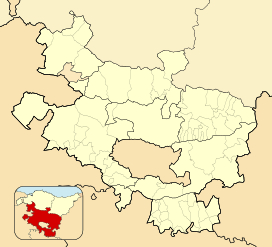La Hoya, Alava
The ancient town of La Hoya (Biasteri, Alava, Basque Country) is a most important archaeological site of the Bronze and Iron Ages of the Basque Country and nearby areas of Spain.
La Hoyako aztarnategi arkeologikoa | |
 Shown within Álava | |
| Location | Binasperi, Lanciego/Lantziego |
|---|---|
| Region | Álava |
| Coordinates | 42°33′54″N 2°35′11.04″W |
| Type | Human settlement |
| Area | 4 ha (9.9 acres) |
| History | |
| Periods | 15th and 3rd centuries BCE |
| Site notes | |
| Archaeologists | Alejandro Sampedro Martínez et al |
The fortified town was inhabited between the 15th and 3rd centuries BCE and occupies four hectares. It has three levels:
- Middle-Late Bronze Age: in this early period, the fortifications, as well the houses, were all made of wood.
- Early-Middle Iron Age: construction became more complex using mixed formulas with stone, wood and adobe. Most houses were near the wall in this period.
- Late Iron Age, with a cultural context that some classify as Celtiberian, shows important changes in urbanization: with paved streets and plazas that form a reticular structure. The wall is also rebuilt on stone. This final period also shows great advancement in the technologies: potter's wheel, elaborated blacksmithing, etc.
The successive layers of rubble, that served as cimentations for further edification, make up a small tell 3 meters high.
The town was destroyed violently c. 300 BCE, leaving the remains of the people and their quotidian tools in the streets.
External links
This article is issued from Wikipedia. The text is licensed under Creative Commons - Attribution - Sharealike. Additional terms may apply for the media files.